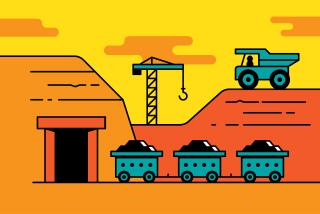The deeper danger of Crandall Canyon
Before the hordes of reporters move on from the Crandall Canyon Mine disaster, taking the nation’s attention with them, we should seize the opportunity to turn this tragedy into a teachable moment -- one that will allow us to look beyond the chilling safety record of the mining industry and focus on the larger issue of worker safety.
During the Bush administration, the Occupational Safety and Health Administration, the agency mandated to oversee workplace safety, has seemed more intent on protecting employers than workers. It has eliminated dozens of safety regulations since 2001 and reduced the categories of recognized workplace injuries. Despite the latter, 4.2 million workers were hurt or became ill -- and 6,800 died from on-the-job injuries -- in 2005, the last year for which government statistics are available.
Why does it take high-profile accidents like the ones in Utah before the well-being of American workers gets noticed and Washington passes and enforces worker-safety laws?
The unsettling reason hangs over the Utah mine cave-in like a cloud of coal dust: More and more frequently, federal regulatory agencies are being used to reward major political donors. Industry hacks are given key government positions not because they are the best people to protect the public interest but because they are ready, willing and able to protect the very industries they are meant to supervise, industries they have often just left.
Take coal mining. This industry has donated more than $12 million to federal candidates since the 2000 election and the beginning of the Bush era, with 88% of that money -- $10.6 million -- going to Republicans.
And what did that largesse buy? Mine safety regulators far more interested in looking out for the financial well-being of mine owners than for the physical well-being of miners.
Exhibit A is President Bush’s “mine safety czar,” Richard Stickler, whose agency approved the controversial mining technique used at the Crandall Canyon Mine. Stickler is a former coal company manager with such a lousy safety record at the companies he’d run that his nomination as head of the Mine Safety and Health Administration was twice rejected by senators from both parties, forcing Bush to sneak him in the back door with a recess appointment.
An overly cozy relationship between regulators and those they regulate is, of course, not limited to the coal industry. The Food and Drug Administration, for example, has long been, as Sen. Charles Grassley (R-Iowa) put it, “under the thumb” of the very pharmaceutical companies it is supposed to oversee. This dysfunctional dynamic has proved especially deadly, with numerous drugs being pulled off the market after causing multiple deaths and serious injuries in patients. We now have a regulatory system in which corporate greed, political timidity and a culture of cronyism have rendered the public good a quaint afterthought.
In such an atmosphere, and with so many industry foxes guarding the henhouse, the role of the media in covering workplace disasters like the one in Utah becomes all the more important. Unfortunately, traditional media coverage of stories like this tends to focus only on the most dramatic aspect of the tragedy -- the desperate attempt to rescue the trapped miners -- while paying scant attention to investigating and reporting on the reasons why the miners were trapped in the first place.
Twelve days after the initial Crandall Canyon Mine collapse, with three rescuers dead, six others injured and the original six miners likely entombed forever, Utah Gov. Jon Huntsman Jr. suggested the time had come to “focus like never before on mine safety.”
But mine safety should have been a key element of the story from Day One. Why did it take the deaths of three rescue workers for those covering the story to get that message?
Instead, the media allowed Robert E. Murray, the co-owner of the mine, to portray himself as the compassionate boss, as opposed to the owner who may have been at least partly responsible for decisions that led to the disaster. They also allowed him to repeatedly make his bogus (and responsibility-avoiding) claim that the mine collapse was the result of an earthquake, without directly challenging him with seismologists’ reports that denied that assertion.
Stickler, acting more like a lap dog than a watchdog, stood by and allowed Murray to dictate the agenda, even though the law specifically states that the MSHA, not mine operators like Murray, should oversee rescue operations and be the liaison to the media and public.
An exception to the kid-glove treatment given Murray and Stickler has been the Salt Lake Tribune. One story this week uncovered documents that proved Murray wasn’t telling the truth when he denied that he had pushed for permission to use a risky mining technique at Crandall Canyon.
Reps. Lynn Woolsey (D-Petaluma) and George Miller (D-Martinez) have promised a congressional probe into the Utah disaster and its aftermath. Such an inquiry is essential, but it should focus on more than the events at Crandall Canyon -- and even on more than mine safety. It should investigate why our political system makes it so easy for the health and safety of U.S. workers to be reduced to an afterthought -- until tragedy strikes, and then only for a short while.
Arianna Huffington, a contributing editor to Opinion, is the editor in chief of huffingtonpost.com.
More to Read
A cure for the common opinion
Get thought-provoking perspectives with our weekly newsletter.
You may occasionally receive promotional content from the Los Angeles Times.










